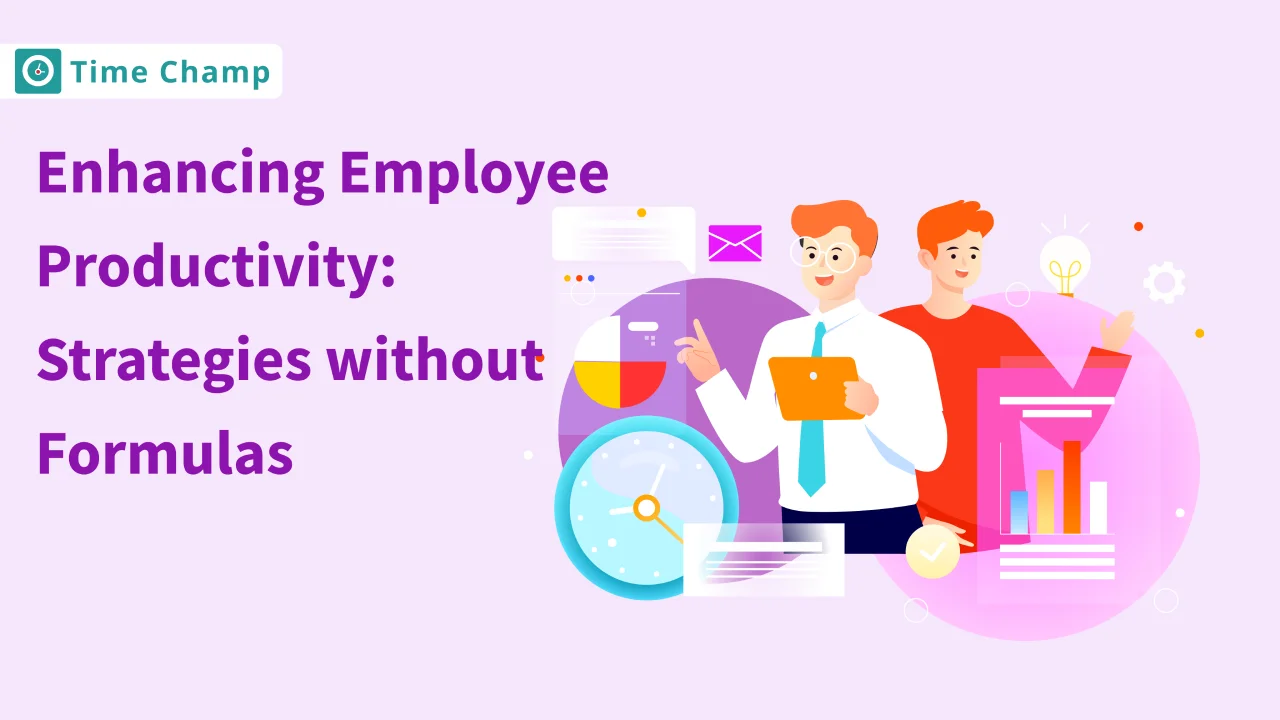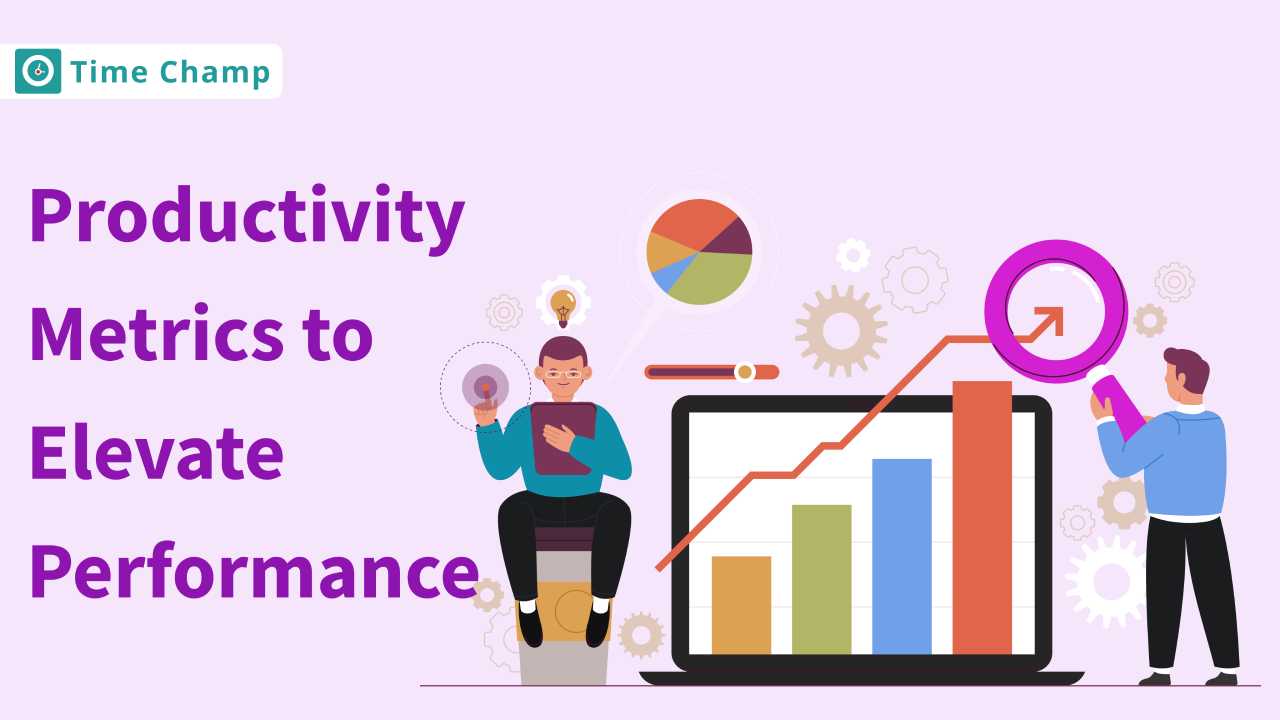Today’s intensely competitive environment requires that the sustainability of any organization rely on productivity. As remote work becomes increasingly common, business leaders are always looking for ways to measure and improve their worker productivity. At the same time that traditional productivity equations and math formulas may provide quantitative epiphanies for a company, they are looking even more at extremely human subjective insights to increase efficiency. As it is impossible to use mathematical formulas, how do you assess the productivity of these employees? In this comprehensive guide, we introduce practical concepts and tactics for becoming a more professional manager. Diving into these methods Let us look at how tools, such as Time Champ, can effectively assist in simplicity-oriented productivity and monitoring.
Measuring Productivity without Numbers
When productivity is discussed, benchmarks and numbers usually become the focus of attention. However, perhaps even more important is getting a grasp on the qualitative factors that help make employees perform better. We will offer various non-numerical ways to measure and enhance productivity in each of these cases.
1. Observational Assessments
When managers see employees in action, they have an excellent opportunity to collect qualitative data on work order efficiency, cooperation, and use of resources. Paying attention to details can even help you discern patterns-such as how long a particular activity has taken or how much time is spent interacting with other people that seems to produce good results.
2. Feedback-Based Evaluations
Feedback sessions with employees are helpful opportunities to understand what challenges they face and what help they need. Through these discussions, the discussions can draw out latent inefficiency and help design solutions that get right to the heart of productivity bottlenecks.
3. Outcome-Focused Measurements
A focus on what gets done rather than the number of hours worked provides a more complete sense of productivity. This strategy acknowledges that high value does not mean long hours, and seeks to motivate employees to do more in less time.
4. Goal Achievement Tracking
Establishing goals, and keeping an eye on results, is a method of evaluation outside of the formula used for assessing productivity. This approach Helps link individual employees ‘actions with the company’s grander mission and creates a sense of direction.
In developing these productivity strategies, however, we shouldn’t overlook the role of technology. Such tools as employee monitoring and productivity can help cultivate an understanding of worker patterns, and thus serve a motivational function that helps improve the effectiveness of non-mathematical operational efficiency improvement methods.
5. Computer Productivity Trackers
But these tools secretly spy on the computer, so that bosses can look over staff members ‘digital habits. When such time-distribution analyses reflect different applications or websites, managers can evaluate whether the application might need a bit of training or the website could do without some distractions.
6. Software for Monitoring Work From Home Productivity
Another issue with remote work is its lack of visibility in terms of employee productivity. Special software can maintain accountability and transparency by monitoring work hours and telling us what’s going on without overstepping the privacy of remote employees.
7. Efficiency Tracking Software
The time one spends on a task multiplied by the amount of work accomplished, efficiency software provides a performance indicator that is both qualitative and quantitative. It can provide information that will help determine the best workflow and workload distribution according to actual results rather than guesswork.
How to be More Efficient without Obsessing Over Formulas
That’s why companies have to take responsibility for building a work environment that promotes productivity, but still allows employees space and time for their own lives. We would like to present some strategies for achieving this purpose.
8. Workforce Time Management
Workforce productivity requires effective time management. Establishing priorities and planning out the work day for everyone, including breaks, can have a great influence on overall output. Using various tools to assist staff with such an organization can free up more work time.
9. Encouraging Employee Autonomy
Once employees are trusted to handle their affairs, they will take the initiative and hope to work economically. To encourage employees to feel empowered, employers should reduce their micromanagement, and thus raise productivity.
10. Tailored Incentive Programs
Creative incentive programs that recognize productivity can spur motivation and thus performance. Through such a match between rewards and behavior, employers can use employees ‘built-in motivators to better their results.
11. Streamlining Communications
Undercommunication is just as bad as overcommunication. Fewer channels and fewer expectations mean less time is spent on meeting items so that impact employees can work on what matters.
Fostering a Productive Work Culture
A productive work ethic has a wide-ranging effect on organizational effectiveness. In this section, we will examine the role of company culture in promoting productivity without formulas.
12. Embracing Flexible Work Arrangements
Recognizing that different employees have their most productive hours at various times of the day, flexible work arrangements can enhance individual performance as well as help with work-life balance.
13. Providing Continuous Learning Opportunities
Thus, the investment in employees ‘development increases their ability and efficiency. The availability of ample opportunities for staff to continue learning helps them to further hone their skills and put new knowledge into practice, increasing productivity.
14. Encouraging Collaboration
The environment of cooperative work is conducive to creativity and innovation. Through team building, companies can better utilize the unique abilities and thinking of their workers to facilitate problem-solving and increase productivity.
15. Recognizing and Rewarding Achievements
Constant commendations for good performance raise morale and encourage high-quality work. Crediting both small successes and big successes helps employees maintain a sense of commitment to their work.
Methods for Measuring Worker Efficiency on the Job?
Productivity understanding and measurement are about more than just work amounts; they’re really about the value of what’s done. Without falling back on mathematical formulae, let’s see how it is possible to forge meaningful measures of performance and productivity.
16. Clear Key Performance Indicator (KPI) Definitions
Defining and using specific KPIs that are related to business results is the most direct method of evaluating work. For instance, customer satisfaction scores or project completion rates can show the level of productivity and give people a chance to adjust their efforts appropriately for individual performance to benefit the company.
17. Peer Reviews and Self-Assessments
Qualitative methods such as peer reviews and self-assessment can give an individual a more in-depth understanding of his or her performance from many different angles. Through building a culture of constructive criticism, employees can work on constant self-improvement and constantly help others.
18. Utilizing Project Milestones
Comparing progress to milestones can be another measurement of productivity. Achieving these benchmarks on schedule or even ahead of time generally reflects a high degree of efficiency and good management planning.
19. Analyzing Impact and Influence
When it’s a bit harder to determine the direct output, you can consider whether or not such an employee affects team functioning, decision-making processes, or company strategy.
How does Work Productivity Monitoring Software help?
We must take up productivity without an excess of math. But we’ll never be able to solely rely on technology for our productivity work–technology needs manpower. Work productivity monitoring software does, however, help in the assessment and improvement of efficiency.
20. Using digital tools to carefully plan and implement the task.
Through task management software, employees can even more smoothly arrange their work. These tools give them visibility into workload, task status, and deadlines so that they can better manage their time.
21. Identifying Areas for Process Improvement
For example, with the help of monitoring software, it can be determined whether there are repetitive areas or bottlenecks in the workflow. Businesses can use this information to simplify operations, automate repetitive jobs, and let their workers be more creative.
22. Encouraging Accountability and Transparency
Aware that their work is being checked on, employees often take a more responsible attitude. That is making employees more aware of how they are using their time, inspiring them to use it better, and discouraging wasting it.
23. Supporting Remote Workforce Management
For remote teams, productivity monitoring software replaces the physical presence of supervisors overall. Secondly, it enables managers to coordinate distributed teams and keep up productivity levels.
Employee Efficiency without Formulas
To improve productivity, efficiency must be the focus. We talk here about how to improve employees ‘efficiency using an approach that goes beyond mere statistics.
24. Cultivating a Supportive Environment
The offering of emotional and operational assistance enables employees to do their job properly. Making positive work relations and keeping a supportive atmosphere are essentials to efficiency.
25. Empowering Decision-Making
Allowing employees to decide for themselves on matters that relate directly to their jobs and responsibilities speeds up processes, giving them a feeling of authority. Better decision-making autonomy can eliminate bottlenecks and create a more dynamic and agile work atmosphere.
26. Leveraging Cross-Training
Of course, aside from ensuring a more versatile staff, the cross-training of various roles and skills has also helped everyone to gain an understanding of how things function within the company so that they can do any task or project faster.
27. Providing Access to Essential Resources
Making sure employees are equipped with the materials, data, and tools they need to do their jobs also saves a lot of time and headaches, so that working hours become more efficiently utilized.
Building a Conducive Remote Workspace
As working credentials have gone remote, supporting productivity in a virtual environment has become a new challenge. What are some ways of keeping high productivity levels in a home-based work environment?
28. Implementing Regular Check-ins
In addition, frequent contact with employees working from home will allow them to share difficulties and ask for feedback. That keeps them interested and on the job.
29. Providing Robust Collaboration Tools
Purchase equipment that is reliable and provides for effective communication between remote teams. Remote work is more productive when effective tools are available with which to easily collaborate and avoid miscommunications.
30. Well-Being, Work-Life Balance The most important factor is focusing on well-being and work-life balance.
Fostering a healthy work-life balance among remote workers is essential to maintaining productivity. Promoting breaks, flexible hours, and mental health creates a happy workforce that is more effective.
31. Setting Boundaries for Work Hours
Given the difficulty of distinguishing between work and personal life by nature in a remote location, it is necessary to tell employees to draw clear boundaries. Setting specific times for work and rest avoids burnout and ensures a balanced pace of life.
Investing in Work Productivity Software: A Strategic Approach
Implementing software designed to increase productivity in the workplace is one of the primary tactics adopted by businesses today. Such technological instruments can also offer much useful non-numerical information to be used in creating a high-performing work culture.
32. Customizable Employee Productivity Tools
Of course, every workplace is different and there should not be a one-size-fits-all approach to productivity. Customizable software lets the managers adjust functions to suit the company so that it gets more use out of this productivity tool.
33. Real-Time Productivity Dashboards
A productivity monitoring tool, for instance, uses interactive dashboards to give real-time information about team performance. Managers can also use these dashboards to easily identify outstanding performers, provide feedback at the moment, and shift resources as needed.
34. Merging Productivity Software Systems with Others
Software built on top of productivity tools can be integrated with existing enterprise systems, eliminating manual data entry and uniting departments in one streamlined workflow.
35. Ensuring Data Security and Privacy
However, when employing software to monitor employee efficiency, data security and privacy must be considered. Furthermore, employers should provide a clear statement regarding the use of software and employ tools that protect information according to employee privacy standards.
Implementing Productivity Improvement Initiatives
Beyond monitoring and measurements, certain programs can promote productivity through concrete steps. All these strategies depend on action and transformation of the company’s operations and culture.
36. Continuous Process Optimization
Only by constantly reviewing and improving business processes can you find great increases in productivity. By welcoming employees ‘suggestions and comments on workflows, it is possible to find new efficiencies and practices.
37. Embracing Agile Methodologies
The agile methods emphasize step-by-step approaches, flexibility, and teamwork. If companies embrace these principles, projects can be completed more quickly, they can respond to change more rapidly and effectively, and people will work better together.
38. Prioritizing Employee Health and Wellness
An unhealthy workforce is an ineffective one. Health-related initiatives emphasizing physical, mental, and work-life balance have also improved attention span, which in turn decreases the number of days missed through illness or burnout.
39. Encouraging Innovation and Creativity
We can create an environment that supports innovation, so employees are more willing to think creatively. This fosters the emergence of new ways to think that will reduce costs, simplify work, and increase efficiency.
Productivity Through Emotional Intelligence Leadership
However the leader’s style of medicine has a huge influence on employee productivity, and those leaders with the greatest emotional intelligence can push their teams to greater levels of efficiency and commitment.
40. Developing Empathetic Leadership
Similar leadership, which is empathetic and understanding of employees ‘personal and professional difficulties, can foster strong relationships based on mutual trust. That can mean a motivated and dedicated workforce that tries its hardest to do the best it can.
41. Encouraging Constructive Feedback
This kind of constructive feedback represents a gateway to constant improvement and self-improvement. As long as leaders are clear, down to earth, and positive in offering feedback, employees will accept the opportunity for improvement.
42. Providing Clear Communication and Direction
Good leaders clearly express what’s expected of them and they have a clear set of goals. This eliminates confusion and brings the individual’s efforts into line with what the organization is striving for.
43. Developing a Culture of Respect and Inclusion
It is only if we have a respectful and inclusive workplace that employees can turn over every rock to bring their whole selves into the workplace. This can also raise morale and help to establish an atmosphere of everyone feels appreciated and contributing.
Conclusion :
Since productivity is not just a single dimension, we cannot use complicated formulas or cold calculations to grasp it. But, as we have found, there are a variety of ways that organizations can approach the question of productivity aimed at assessing qualitative outcomes. Tools such as Time Champ can be useful allies in this battle, providing insight, monitoring, and improving workflow without obscuring the nature of what it means to be productive.
This is simply a matter of providing an ideal environment for employees to maximize their potential, give free rein to their creativity, and be proactive. If companies invest in people, show confidence in their abilities, and give them the necessary equipment and assistance they need to do a good job, results will come of themselves. It is highly beneficial for individuals as well as organizations generally.
FAQs:
Leaders with high emotional intelligence who provide clear communication, constructive feedback, and foster a culture of respect and inclusivity can positively impact and drive employee productivity.
Work productivity monitoring software helps managers and teams stay aligned with goals, ensures efficient use of time, and provides data for informed decision-making regarding productivity strategies.







